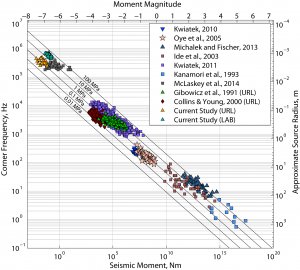
At the largest scale, fractures give rise to volcanoes and earthquakes and at engineering scales they form pathways for fluids to flow through and reduce the strength of rock. For these reasons, the study of rock fractures has been a major focus of research in the mining, petroleum and civil engineering industries for decades. To study rock fractures in detail and under controlled conditions, laboratory experiments are conducted where radiated Acoustic Emission (AE) is thought to be analogous to earthquakes.
The focus of this research is to bridge the gap between AE produced during small scale laboratory experiments and larger manmade and natural earthquakes via the absolute calibration of AE sensors. After calibration of our AE sensors, we able to estimate the size and magnitude of AE events induced during a true-triaxial deformation experiment. We found that corner frequency and moment magnitude ranged from 180 < fo < 800 kHz and -7.1 < Mw < -6.2, respectively and all source parameters appeared to obey scaling relationships derived for larger earthquakes.
Related Publications
- Goodfellow, S.D., and R.P. Young (2014), A laboratory acoustic emission experiment under in situ conditions, Geophysical Research Letters, 41, pp. 3422 – 3430.
-
Goodfellow, S.D., M.H.B. Nasseri, and R.P. Young (2014), “Source parameters of acoustic emissions observed in laboratory and mine environments”, ARMA Conference, June 1 – 4, 2014, Minneapolis, Minnesota, USA, pp 1-7.